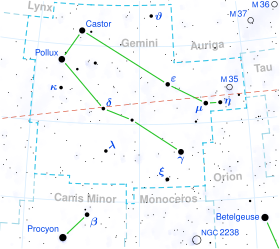Delta Geminorum
| Observation data Epoch J2000 Equinox J2000 | |
|---|---|
| Constellation | Gemini |
| Right ascension | 07h 20m 07.37978s[1] |
| Declination | +21° 58′ 56.3377″[1] |
| Apparent magnitude (V) | +3.53[2] |
| Characteristics | |
| Spectral type | F0 IV[3] |
| U−B color index | +0.04[2] |
| B−V color index | +0.34[2] |
| Absolute magnitude (MV) | 1.95[5] |
| Details | |
Gyr | |
| Database references | |
| SIMBAD | data |
Delta Geminorum (δ Geminorum, abbreviated Delta Gem, δ Gem), formally named Wasat /ˈweɪsət/,[9][10] is a triple star system in the constellation of Gemini.
Nomenclature
δ Geminorum (Latinised to Delta Geminorum) is the system's Bayer designation.
It bore the traditional name Wasat, which derives from the Arabic word for "middle".[11][12] In 2016, the International Astronomical Union organized a Working Group on Star Names (WGSN)[13] to catalogue and standardize proper names for stars. The WGSN approved the name Wasat for this star on 21 August 2016 and it is now so entered in the IAU Catalog of Star Names.[10]
In Chinese, 天樽 (Tiān Zūn), meaning Celestial Wine Cup, refers to an asterism consisting of Delta Geminorum, 57 Geminorum and Omega Geminorum.[14] Consequently, Delta Geminorum itself is known as 天樽二 (Tiān Zūn èr, English: the Second Star of Celestial Wine Cup.).[15] From this Chinese name, the name Ta Tsun has appeared.[16]
Properties

Delta Geminorum is a
It has an
Delta Geminorum is a triple star system. The inner components form a
References
- ^ S2CID 18759600
- ^ Bibcode:1966CoLPL...4...99J
- ^ Centre de Données astronomiques de Strasbourg, retrieved 2011-06-03
- ^ )
- S2CID 8642707
- ^ S2CID 119226823
- ^ S2CID 11027621
- ^ ]
- ISBN 978-1-931559-44-7
- ^ a b IAU Catalog of Star Names, retrieved 28 July 2016
- ^ Kaler, Jim (n.d.), "WASAT (Delta Geminorum)", Stars (University of Illinois sponsored website), retrieved July 29, 2014,
The name is a mess, "Wasat" meaning "middle" in Arabic, but the middle of WHAT is not clear, whether the middle of Gemini, of the sky, or of the neighboring constellation Orion (which the Arabs referred to as the "Central One"), the star name improperly applied to our Delta.
- ^ Allen, Richard (1889). "The history of the star: Wasat, from p.234 of Star Names, Richard Hinckley Allen, 1889". Constellations of Words website. Retrieved July 29, 2014.
Wasat and Wesat are from Al Wasat, the Middle, i.e. of the constellation; but some have referred this to the position of the star very near to the ecliptic, the central circle.
- ^ IAU Working Group on Star Names (WGSN), International Astronomical Union, retrieved 22 May 2016
- ISBN 978-986-7332-25-7.
- ^ (in Chinese) 香港太空館 - 研究資源 - 亮星中英對照表 Archived August 19, 2010, at the Wayback Machine, Hong Kong Space Museum. Accessed on line November 23, 2010.
- ^ Richard Hinckley Allen: Star Names — Their Lore and Meaning: Gemini
- ^ King, Bob (12 December 2013), "To Delta Geminorum by way of Jupiter and Pluto", Astro Bob, Areavoices.com, retrieved 13 December 2013
- ^ In the Sky Earth astronomy reference utility showing the ecliptic and relevant date as at J2000 - present
- ISBN 0-521-82796-5
- doi:10.1086/431207
- University of Illinois, retrieved 2012-01-30
External links
- Delta Geminorum on

